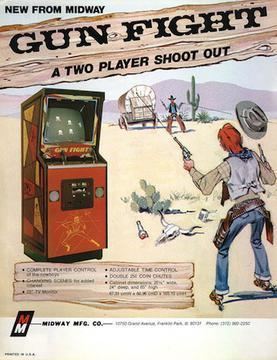8 /10 1 Votes
Series Gun Fight Cabinet Upright Genre Shoot 'em up | 4/5 Emuparadise Mode(s) Two-player Initial release date 1975 | |||||||||||||||||||||||||||||||||
 | ||||||||||||||||||||||||||||||||||
Programmer(s) Tom McHugh (US version) CPU Discrete logic (Taito)8080 @ 1.9968 MHz (Midway) Publishers Midway Games, Taito, Interceptor Micros Similar Midway games, Shooter games | ||||||||||||||||||||||||||||||||||
Arcade game gun fight 1975 midway dave nutting associates re uploaded
Gun Fight, known as Western Gun in Japan and Europe, is a 1975 arcade shooter game designed by Tomohiro Nishikado, and released by Taito in Japan and Europe and by Midway in North America. It was the first video game to depict human-to-human combat, while the Midway version was also the first video game to use a microprocessor. Following its November 1975 release in North America, it went on to sell over 8,000 arcade cabinets in the United States. It was ported to the Bally Astrocade video game console as a built-in game in 1977 as well as several home computer platforms.
Contents
- Arcade game gun fight 1975 midway dave nutting associates re uploaded
- 1975 midway gun fight arcade game
- Gameplay
- Development and technology
- Series
- Ports
- References
The theme of the game involves two Old West cowboys armed with revolvers and squaring off in a duel. Whoever shoots the other cowboy first wins the duel. Unlike in a real-life duel, however, both cowboys get numerous opportunities to duel in order to score points (one point per successful draw). The game was included in GameSpy's "Hall of Fame" in 2002.
1975 midway gun fight arcade game
Gameplay
Western Gun was a fixed screen shooter where two players could compete in an old west gun fight. It was the first video game to depict human-to-human combat. When shot, the characters in the game fell to the ground and the words "GOT ME!" appeared above the body. The game had two distinct joystick controls per player, with one eight-way joystick for moving the computerized cowboy around on the screen and the other for changing the shooting direction. Unlike other dual joystick games, Western Gun has the main joystick on the right instead of the left.
Other features of the game included obstacles between the characters which block shots, such as a cactus, and (in later levels) stagecoaches. The guns have limited ammunition, with each player given six bullets; a round ends if both players run out of ammo. Gunshots can also ricochet off the top or bottom edges of the playfield, allowing for indirect hits to be used as a possible strategy.
Development and technology
Taito gave Western Gun artwork of cowboys in the Wild West on the video game arcade cabinet which matched the in-game graphics featuring cacti, covered wagons, rocks, and human characters. In contrast to earlier games which used miniature shapes to represent abstract blocks or spaceships, Western Gun featured cartoon-like human characters. The game use bitmapped framebuffer technology to display animated human-like characters, using Fujitsu's MB14241 video shifter chip, which was also later used by Sea Wolf and Space Invaders. Tiles are also used to display text.
Taito licensed its game Western Gun to Midway for release in North America, one of the first such licenses, after the 1974 scrolling racing game Speed Race, also designed by Tomohiro Nishikado, and the 1974 sports game Basketball. The title Western Gun, while making perfect sense for Japanese audiences in that it conveys the setting and theme as simply as possible, was considered to have sounded odd to American audiences, so it was renamed Gun Fight instead for its American localization.
Tomohiro Nishikado's original Western Gun design was based on discrete logic, like most video arcade games of the time. When Dave Nutting adapted it for Midway, he decided to base it on the Intel 8080, which made Gun Fight the first video game to use a microprocessor, since his company Dave Nutting Associates had already licensed the technology for the first arcade pinball machine to include a microprocessor, The Spirit of '76. Nishikado believed that his original version was more fun, but was impressed with the improved graphics and smoother animation of Midway's version. This led him to design microprocessors into his subsequent games, including the blockbuster 1978 shoot 'em up hit Space Invaders. Gun Fight uses a black-and-white raster monitor and a yellow screen overlay.
Series
Ports
In 1978, the game was introduced to the home market with its port to the Bally Astrocade console, which included a color version of the game within the system's ROM. That same year, David Crane programmed his own version of the game, entitled Outlaw, released by Atari for the Atari 2600 console and by APX for the Atari 8-bit computers. Sears also released a version for the Atari 2600 called Gunslinger that year.
In 1981, the game was ported to the Atari 8-bit family personal computers by Hofacker / Elcomp Publishing. In 1983, Epyx also ported Gun Fight and another Midway game, Sea Wolf II, to the Atari 8-bit family, and released them in an "Arcade Classics" compilation. In 1987, Interceptor Software ported Gun Fight to the Commodore 64 and Commodore 128 computers.
The 1985 Commodore 64 game The Duel is obviously heavily inspired by and very similar to Gun Fight.
